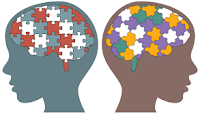The Severity Levels of Autism
RE: "What's the difference between level 1 autism and high-functioning autism?"
The DSM 5 (Diagnostic and Statistical Manual of Mental Disorders, 5th Edition) specifies the severity levels of Autism as follows:
Level 1: Requiring Support—
• Social Communication: With supports in place, deficits in social communication cause noticeable impairments. Has difficulties initiating social interactions, and demonstrates clear examples of atypical or unsuccessful responses to social overtures of others. May appear to have decreased interest in social interactions. [Note: Level 1 autism is most commonly referred to as high-functioning autism.]
• Restricted Interests and Repetitive Behaviors: Rituals and repetitive behaviors (RRB’s) cause significant interference with functioning in one or more contexts. Resists attempts by others to interrupt RRB’s or to be redirected from fixated interest.
Level 2: Requiring Substantial Support—
• Social Communication: Marked deficits in verbal and nonverbal social communication skills; social impairments apparent even with social supports in place; limited initiation of social interactions and reduced or abnormal response to social overtures from others.
• Restricted Interests and Repetitive Behaviors: RRB’s and/or preoccupations or fixated interests appear frequently enough to be obvious to the casual observer and interfere with functioning in a variety of contexts. Distress or frustration is apparent when RRB’s are interrupted; difficult to redirect from fixated interest.
Level 3: Requiring Very Substantial Support—
• Social Communication: Severe deficits in verbal and nonverbal social communication skills cause severe impairments in functioning; very limited initiation of social interactions and minimal response to social overtures from others.
• Restricted Interests and Repetitive Behaviors: Preoccupations, fixated rituals and/or repetitive behaviors markedly interfere with functioning in all spheres. Marked distress when rituals or routines are interrupted; very difficult to redirect from fixated interest or returns to it quickly.
So as you can see, Level 1 would be considered high-functioning Autism. Disability will be common among children with Level 3 Autism and non-existent in Level 1 (where children currently diagnosed with Aspergers will be reclassified).
==> Parenting Children and Teens with High-Functioning Autism
The new method for diagnosing Autism replaces the five prior diagnoses: Asperger Syndrome, Pervasive Developmental Disorder Not Otherwise Specified (PDD-NOS), Childhood Disintegrative Disorder, and Autistic Disorder. If a child has a pre-existing diagnosis of any of these disorders, he or she is automatically considered to have an Autism diagnosis.
Children who are being newly diagnosed (or re-evaluated) and do not fit into the new criteria for Autism may receive a new diagnosis called Social Communication Disorder. This appears to be an extremely mild version of Autism (the child does not have sensory issues or repetitive behaviors) and is similar in many ways to the old PDD-NOS.
The DSM-5 defines Autism as a single “spectrum disorder,” with a set of criteria describing symptoms in the areas of social communication, behavior, flexibility, and sensory sensitivity. If a child has symptoms in these areas, he or she will probably be diagnosed as “on the spectrum.” When a physician diagnoses a youngster with Autism, it's important to know the severity of the disorder. If the physician does give his/her opinion on the severity, it’s with the disclaimer that it’s only an opinion, not a medical diagnosis. Whether the opinion is that it's severe, or that it's mild, it has no bearing on the actual diagnosis. A youngster with Autism deemed as mild is just as autistic as one believed to be severe. The medical diagnosis for both is exactly the same.
Autistic kids have issues with social interactions, behavioral issues, restricted interests, self-stimulatory activities and sensory issues. So severity in each of these categories needs to be determined to assess severity as a whole. While the severity of Autism is not a diagnosis, physicians who specialize in Autism can tell where a youngster is in relation to the other kids they have treated. The same youngster will get different opinions of severity from different people. Since determining a “Level” is subjective and not a technical diagnosis, there is no right or wrong answer.
The severity of Autism changes not only day to day, but also situation to situation. For example, autistic kids may exhibit significant social deficits when trying to play with their peers on the playground -- but in the classroom, they may blend in perfectly with their peers. Autism severity is simply a place to start. It’s something to use to help the youngster make progress by getting more services and to help describe the youngster to therapists, teachers, etc. It’s just a snapshot, not something that reflects the future or the youngster in all situations.



